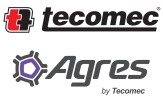GNSS antenna installation is a simple process, but the installation details are extremely important for the correct functioning of the GeoNave system.
- The antenna has a magnetic base, which attaches strongly to ferromagnetic metal surfaces.
- If the surface is not magnetic, the circular metal plate accessory for non-magnetic surfaces must be glued using the double-sided tape already attached to it. The surface must be clean and dry for good adhesion.
- The installation location of the antenna must be as flat as possible, and aligned with the machine’s chassis, preventing the antenna from tilting in any direction.
- Obstructions to the sky view should be avoided, such as tractor exhaust and air filter, in order not to compromise signal reception from satellites.
- Avoid installing the GNSS antenna close to the machine’s radio antennas, which can cause interference and consequent loss of signal quality.
- Avoid installing in locations subject to a lot of vibration during operation.
- The antenna
should preferably be installed on the agricultural machine roof, centralized in relation to the vehicle longitudinal axis and as far forward as possible, as shown in the image below. It is recommended to use a measuring tape to position correctly.
- Do not cut, twist or bend the GNSS antenna cable, avoiding degradation and loss of satellite signal.



